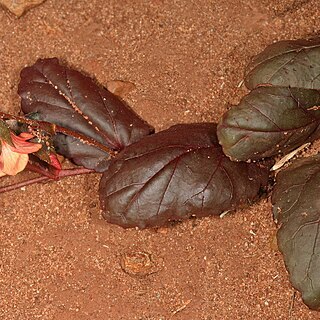Perennial herb, 0.03-0.40 m high. Stems procumbent. Leaves flat on ground; blade ± ovate, < 4 x as long as broad, green, usually tinged reddish brown to purplish, margins crenate-serrate, upper and lower surfaces with glabrescent hairs. Flowers: in 2-flowered cymes with long flowering axes and pedicels; calyx campanulate, deeply lobed; petals salmon-pink to red or yellow, often with darker veins; Sep.-Mar.
Creeping, perennial herb. Leaves ovate, less than 4 times as long as broad, usually tinged reddish brown to purplish, margin crenate-serrate. Inflorescence a 2-flowered cyme with long flowering axes and pedicels. Petals often with darker veins. Flowers salmon-pink to red or yellow.
Habit and general appearance similar to H. quartiniana but leaf-lamina up to 4 × 2·5 cm., ovate to ovate-oblong, margin irregularly crenate, rounded to subcordate, subglabrous and often purplish or bronzy above.
Petals c. 8 × 4 mm., orange-yellow or reddish and somewhat broader than in H. quartiniana, and calyx, ovary and petal-bases glandular (as also in some forms of H. quartiniana).
A creeping herb. It keeps growing from year to year. It grows 3-4 cm high. The leaves are flat on the ground. The leaves are oval.
Style c. 3 mm. long.

